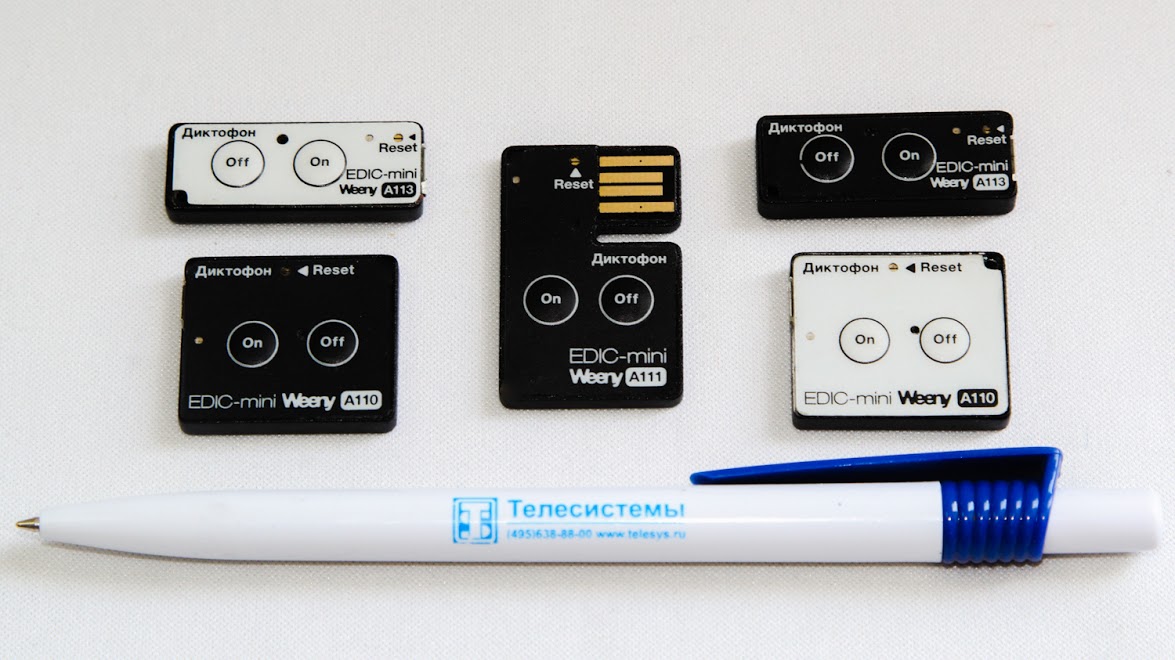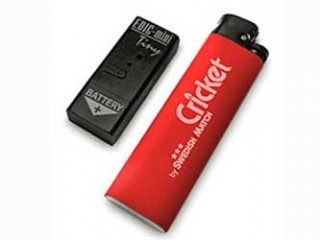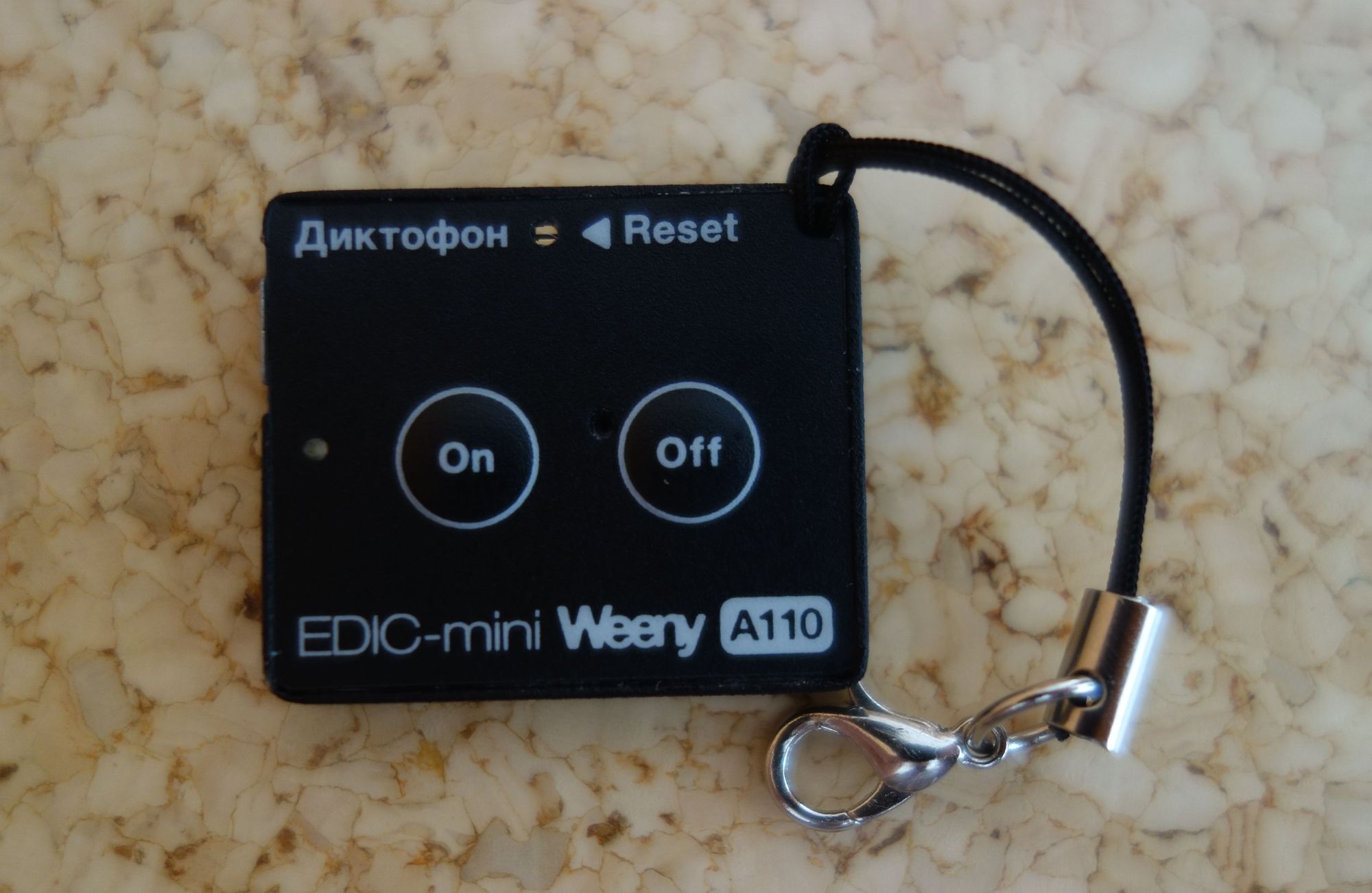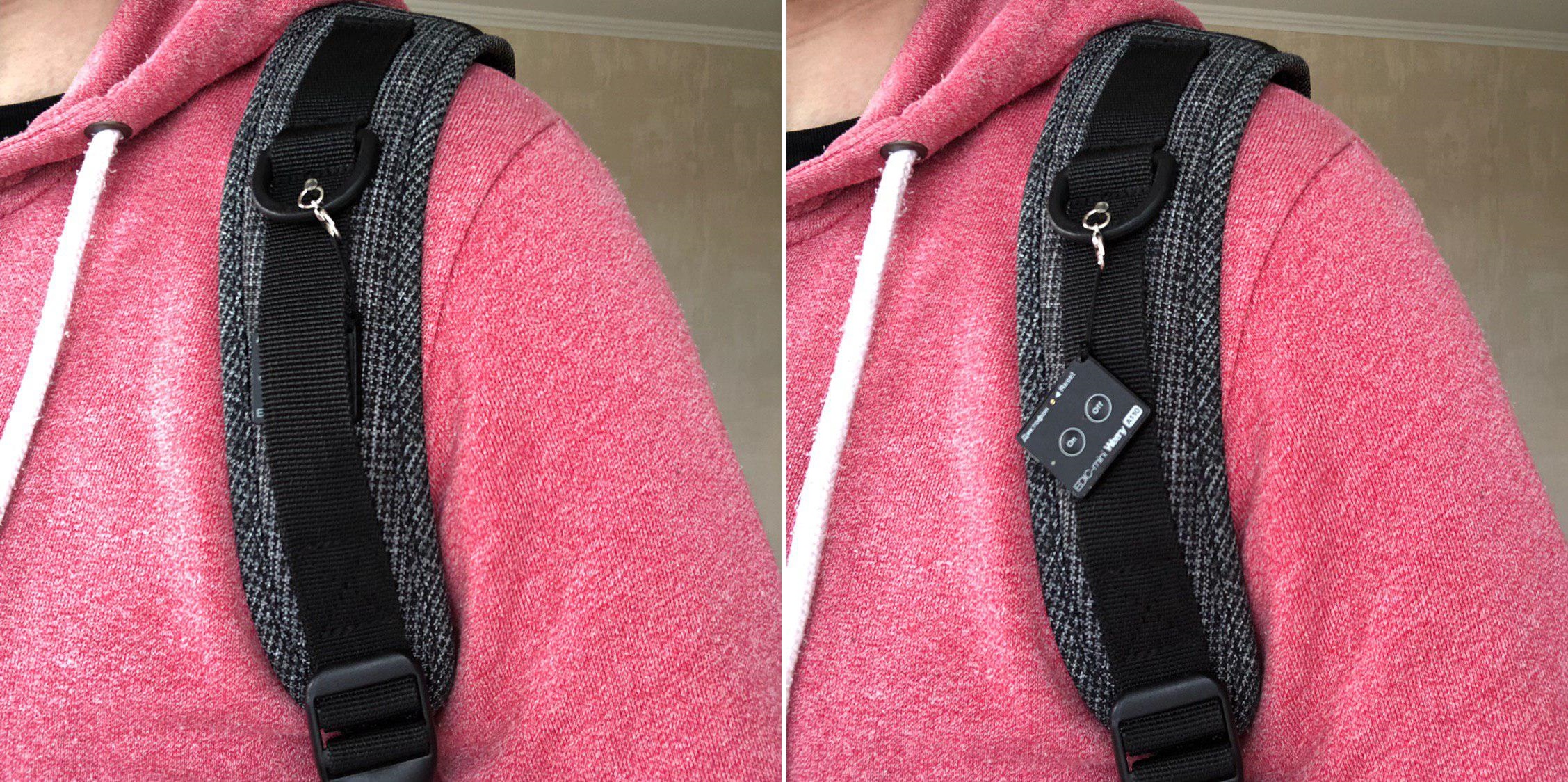Review of the recorder Edic Weeny A110 with the function of the "black box"
I wrote about the Zelenograd company Telesystems, which produces the smallest voice recorders in the world, back in shaggy 2010 ; then "Telesystems" even organized for us a small habraxcourse to production .
Voice recorder Weeny A110 from the new Weeny / Dime line in the size of 29x24 mm, weighing 4 grams and 4 mm thick. At the same time, in the Weeny line there is also a thinner A112 model with a thickness of only 2 millimeters with frontal dimensions of 38x24 mm. And the smallest model in the line is Weeny A113 measuring 37x15x4.5 mm and weighing 4 grams.

"Telesystems" have been holding the brand since 2004, when the Edic Mini A2M recorder measuring 43x36x3.2 mm and weighing 8 grams fell into the Guinness Book of Records. The maximum recording time was 600 hours. In 2007, the Edic-mini Tiny B21 model (8x15x40 mm, 6 grams with a pretty decent memory of 8 GB) fell into the book of records.


For their miniature size, Weeny voice recorders have a pretty impressive list of features. The user of A110 and other Weeny series recorders can:
On the surface of the Weeny A110, two On and Off buttons, a single-color LED, a microphone and a contact to reset the settings fit.

Separate On and Off buttons allow you to turn recording on and off by touch. At first glance, it is embarrassing that they are identical in shape and the symmetry of their arrangement, but this is the price of miniature.
The LED indicates the start / end of recording, the status of the memory and battery during recording and during the charging process. This is a fairly large number of tasks for one light bulb that can burn in only one color - as a result, the method of transmitting information about the state of the recorder resembles Morse code: to understand, you need to monitor the number and interval of blinking LEDs.
In practice, such mechanics were not very convenient. In place of the Telesystem, I
I wouldn’t invent a bicycle, but simply copy any existing successful mechanics. I don’t even have to go far for an example: the principle of using an LED on my JBL E25BT headset, which uses a two-color LED, is great for use in a voice recorder: blue indicates the use of Bluetooth, and blue indicates the battery status (it starts to blink, when it sits down, it constantly glows during charging and goes out at its completion).
The rest of the settings are “hidden” in the config_w.ini file, which can be opened with the usual Notepad when connecting the recorder to a computer like a regular USB flash drive.

It’s not difficult to understand, in principle, although a user who is accustomed to managing gadgets through special applications, only one proposal to get into the configuration file to change the settings can be disabled for a short time.
The online configuration configurator with the more familiar and user-friendly “non-advanced PC user” interface in the form of a special web page will help him get back into operation. I saw this configurator, it looks quite usable, but before the official release of Telesystems it was asked not to show it to anyone yet.
And there, you look, and the mobile application will appear.
Password setting
Recording Mode Setting
Microphone gain level
Loop recording
The loop recording or “black box mode” is one of the most interesting features of the telesystem voice recorders. In the loop recording mode, the recorder records continuously, turning it off preserving sound for the last period of time. In the settings you can set the desired interval.
This is probably the most valuable feature for the recorder: in normal situations, this seems to be unnecessary, but unforeseen circumstances are unforeseen that it is impossible to recognize the moment “but it would be better to record it on audio”. And in such situations, it may not be possible to enable recording in principle.
Having set up the black box mode in advance, you can get out of any incomprehensible situation with a documented record of what is happening, which can be attached as evidence in court.

Voice activation system
Setting timer recording
Reset to factory settings

By default, the recorder is set to 16x16 (16 kHz / 16 bit), giving about two and a quarter hours of recording. It was in this mode that I tested the recorder, first making a short two-minute record, and then just turned it on and went for a walk with it, leaving it to record all the way to see how long it lasts until the memory is full.

After returning home after a few hours, I checked the contents of the recorder. In addition to config_w.ini, two wav files with a duration of two minutes sixteen seconds and two hours seventeen minutes appeared in the device’s memory.

Thus, the total recording time in 16x16 mode was 2 hours 19 minutes.
However, hanging the recorder on the strap of a backpack, and walking with it as with an audio recorder is one of the most simple options for using the capabilities of Edic. In Canada, telesystem voice recorders were attached to the collar , which scientists put on wild lynxes to record how successfully they hunt, according to the sounds made by the victim and the sounds of bone crunch in the teeth of the lynx.

Wav files can be played without any problems with standard iTunes media players, Windows Media Player, and, of course, all others, like VLC.
However, for this you first need to connect to the computer via cable - and this is a limitation. The microUSB to USB 2.0 adapter that comes with the kit, by the way, will not fit Macs of the latest generations that have already switched to USB-C) and the inability to see and listen to the contents of the recorder’s memory without a computer at hand.
Miniature miniature, but if we add Bluetooth connectivity to Weeny recorders to listen and send recordings on the go, this compact device will turn into one of the most powerful “harvesters” on the market.
Voice recorder Weeny A110 from the new Weeny / Dime line in the size of 29x24 mm, weighing 4 grams and 4 mm thick. At the same time, in the Weeny line there is also a thinner A112 model with a thickness of only 2 millimeters with frontal dimensions of 38x24 mm. And the smallest model in the line is Weeny A113 measuring 37x15x4.5 mm and weighing 4 grams.

"Telesystems" have been holding the brand since 2004, when the Edic Mini A2M recorder measuring 43x36x3.2 mm and weighing 8 grams fell into the Guinness Book of Records. The maximum recording time was 600 hours. In 2007, the Edic-mini Tiny B21 model (8x15x40 mm, 6 grams with a pretty decent memory of 8 GB) fell into the book of records.


For their miniature size, Weeny voice recorders have a pretty impressive list of features. The user of A110 and other Weeny series recorders can:
- set the sampling frequency (from 8 to 22 kHz);
- select recording quality (from 4 to 24 bits);
- set daily or one-time timer recording;
- activate or deactivate the activation of recording by sound, indicating the sound level to be triggered;
- set a password to access the contents of the memory.
On the surface of the Weeny A110, two On and Off buttons, a single-color LED, a microphone and a contact to reset the settings fit.

Separate On and Off buttons allow you to turn recording on and off by touch. At first glance, it is embarrassing that they are identical in shape and the symmetry of their arrangement, but this is the price of miniature.
When there is a desire to make the minimum size of a special freedom to be located, alas, no. But which one of them is perfectly grope through the USB connector.
The LED indicates the start / end of recording, the status of the memory and battery during recording and during the charging process. This is a fairly large number of tasks for one light bulb that can burn in only one color - as a result, the method of transmitting information about the state of the recorder resembles Morse code: to understand, you need to monitor the number and interval of blinking LEDs.
- Three short flashes when you press the On button - the recorder is turned on, recording has begun;
- one longer flash when Off is pressed - the recorder is turned off, recording is completed;
- two series of short flashes (from one to four in each series) during recording, the recorder reports the status of the battery (first series of flashes) and memory (second series of flashes). The more outbreaks - the less left (it would be more logical to do the opposite);
- smooth blinking at intervals of one to four seconds indicates the progress of charging when connected to a power source. The smaller the interval, the higher the charge level.
In practice, such mechanics were not very convenient. In place of the Telesystem, I
I wouldn’t invent a bicycle, but simply copy any existing successful mechanics. I don’t even have to go far for an example: the principle of using an LED on my JBL E25BT headset, which uses a two-color LED, is great for use in a voice recorder: blue indicates the use of Bluetooth, and blue indicates the battery status (it starts to blink, when it sits down, it constantly glows during charging and goes out at its completion).
The rest of the settings are “hidden” in the config_w.ini file, which can be opened with the usual Notepad when connecting the recorder to a computer like a regular USB flash drive.

It’s not difficult to understand, in principle, although a user who is accustomed to managing gadgets through special applications, only one proposal to get into the configuration file to change the settings can be disabled for a short time.
The online configuration configurator with the more familiar and user-friendly “non-advanced PC user” interface in the form of a special web page will help him get back into operation. I saw this configurator, it looks quite usable, but before the official release of Telesystems it was asked not to show it to anyone yet.
We are not releasing it now in order to allow the format of the configuration file to settle down, so that later there will be no mess with a bunch of version versions.
And there, you look, and the mobile application will appear.
Password setting
; 8 ( ). ; 00000000. ; . . . ; Password length might not exceed 8 characters (only English charset is supported). ; To reset a forgotten password type 00000000 as password value. ; Warning! When you reset the password, all records will be erased without the possibility of recovery. Password=
Recording Mode Setting
; ( . (MaxTime), ) ; Record mode (the shorter the max record time, the better the record quality) ; 0 - PCM 22 KHz 24 bit, MaxTime: ~1 h 00 min ; 1 - PCM 22 KHz 16 bit, MaxTime: ~1 h 30 min ; 2 - PCM 16 KHz 24 bit, MaxTime: ~1 h 30 min ; 3 - PCM 16 KHz 16 bit, MaxTime: ~2 h 15 min ; 4 - PCM 8 KHz 24 bit, MaxTime: ~3 h 00 min ; 5 - PCM 8 KHz 16 bit, MaxTime: ~4 h 30 min ; 6 - uLaw 8 KHz 8 bit, MaxTime: ~9 h 00 min ; 7 - ADPCM 8 KHz 4 bit, MaxTime: ~18 h 00 min RecordMode=3
Microphone gain level
; 1 - (0dB), 2 - (+6dB (2)), 3 - (+12dB (4)),.... 7 - (+42dB (128)) ; Microphone gain level: 1..7, ; 1 - lowest (0dB), 2 - (+6dB (2)), 3 - (+12dB (4)),.... 7 - (+42dB (128)) highest GainLevel=5
Loop recording
The loop recording or “black box mode” is one of the most interesting features of the telesystem voice recorders. In the loop recording mode, the recorder records continuously, turning it off preserving sound for the last period of time. In the settings you can set the desired interval.
; (), 0 – ; Size of one part of the cycle recording (minutes), 0 – Cycle recording off CycleLength=0
This is probably the most valuable feature for the recorder: in normal situations, this seems to be unnecessary, but unforeseen circumstances are unforeseen that it is impossible to recognize the moment “but it would be better to record it on audio”. And in such situations, it may not be possible to enable recording in principle.
Having set up the black box mode in advance, you can get out of any incomprehensible situation with a documented record of what is happening, which can be attached as evidence in court.
all information can be divided into legally protected and available for fixation and use. Accordingly, the first cannot be recorded and used in any way (for example, it will be illegal to adapt audio and video recording devices for attempts to secretly obtain personal and family secrets, information transmitted via communication networks, commercial, banking and state secrets). But the conversation of the driver or another citizen with a law enforcement officer in the line of duty does not apply to such information. Or recording a conversation by one of its participants is a legal action, and the possibility of recording it by an outside party is regulated by law.
“ Using audio and video to protect rights. Highlights

Voice activation system
; (VAS): 0 – ; 1 - ; Voice activation system (VAS): 0 – disabled; 1 - enabled VasEnabled=0 ; VAS: 0-100(%) ; Silence level: 0-100(%) VasLevel=15 ; VAS: (1..15 ) ; Silence duration (1..15 sec) VasDuration=5
Setting timer recording
; : 0 – ; 1 – ; 2 - ; Timer recording: 0 – off; 1 – Daily; 2 - Once RecTimer=0 ; / ( DD/MM/YYYY HH:MM). ; , . ; Start and end time (DD/MM/YYYY HH:MM format) for timer recording. ; For Daily timer the start and the stop date is ignored, but must be present. TimerStartDateTime=9/05/2019 13:45 TimerStopDateTime=10/05/2019 3:30
Reset to factory settings
; *** : 42 - . !!! *** ; . ; *** Reset to factory state: 42 - reset. WARNING!!! *** ; All records will be erased and the settings will be set by default. ResetToFactoryState=0

By default, the recorder is set to 16x16 (16 kHz / 16 bit), giving about two and a quarter hours of recording. It was in this mode that I tested the recorder, first making a short two-minute record, and then just turned it on and went for a walk with it, leaving it to record all the way to see how long it lasts until the memory is full.

After returning home after a few hours, I checked the contents of the recorder. In addition to config_w.ini, two wav files with a duration of two minutes sixteen seconds and two hours seventeen minutes appeared in the device’s memory.

Thus, the total recording time in 16x16 mode was 2 hours 19 minutes.
However, hanging the recorder on the strap of a backpack, and walking with it as with an audio recorder is one of the most simple options for using the capabilities of Edic. In Canada, telesystem voice recorders were attached to the collar , which scientists put on wild lynxes to record how successfully they hunt, according to the sounds made by the victim and the sounds of bone crunch in the teeth of the lynx.

Wav files can be played without any problems with standard iTunes media players, Windows Media Player, and, of course, all others, like VLC.
However, for this you first need to connect to the computer via cable - and this is a limitation. The microUSB to USB 2.0 adapter that comes with the kit, by the way, will not fit Macs of the latest generations that have already switched to USB-C) and the inability to see and listen to the contents of the recorder’s memory without a computer at hand.
Miniature miniature, but if we add Bluetooth connectivity to Weeny recorders to listen and send recordings on the go, this compact device will turn into one of the most powerful “harvesters” on the market.
All Articles